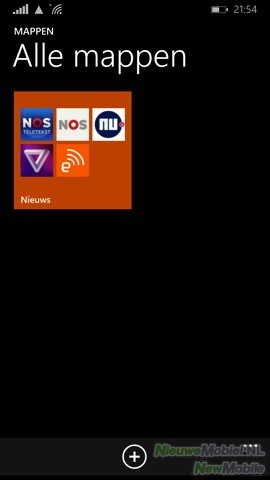Display
The screen of the Lumia 930 has a resolution of 1920 × 1080 pixels. The Lumia 1520 already had such a Full HD resolution but that was on a considerably larger screen. The screen is of the so-called ClearBlack AMOLED type. As we are used to from such screens, colors and black areas are displayed very deep and vividly. White areas, on the other hand, do not come out quite right. To improve this, you can play a bit with the color profile in the settings. The automatic screen brightness works very accurately and ensures that the screen is pleasant to read in all circumstances.



There are different setting options for the display but they are rather scattered throughout the settings menu. As this menu is not sorted by alphabet or category you may need to search for 'screen time-out', brightness, screen rotation or other options.
Menu
Windows Phone is a colourful and striking whole. For the interface, background color, accent color and background picture can be set. When you set a background picture, the tiles that are normally executed in the accent color will become transparent. Because the Lumia 930 runs on version 8.1 of Windows Phone it has some much needed improvements.



For example, there is a notification screen that we already knew from iOS and even earlier from Android. This notification window or action center can be opened by dragging the notification bar down. Notifications of new messages are of course displayed here. Furthermore, the remaining battery percentage, the date, four configurable shortcuts to specific settings and a link to the settings menu are displayed at the top.



For the lock screen, an application can be selected that provides the background with interactive information. Think for example of the weather or your calendar. Furthermore, one app can be selected for detailed status information and five apps for quick status information. More fun are the dynamic lock screen themes. There is already a beta downloadable from the Store and it looks very slick.



The Live Tiles on the home screen get more and more functionality and really bring your home screen to life. Incidentally, not all tiles have a live view and for some it also depends on their size. So it pays to tinker a bit with the layout of your start screen. For an overview, there is always an alphabetical list of all installed apps next to the start screen. Although this list can become quite long after a while.



Something else new is his folders. You can't use them by default, you'll have to download an app first. Therefore it doesn't feel very integrated but basically it does what it promises; putting apps in folders and then placing them on your home screen.



".
In principle, the operating system works smoothly and user friendly. It only still gives the feeling that it is not completely finished. For example, the notification screen appears exactly the same as with Android and doesn't move the whole screen as you do when you open the menu. Furthermore, there are no separate icons in the status bar for notifications of different applications. In general, the interface makes a rather syrupy impression. There are no hiccups, but all the transition animations do cause some delay.